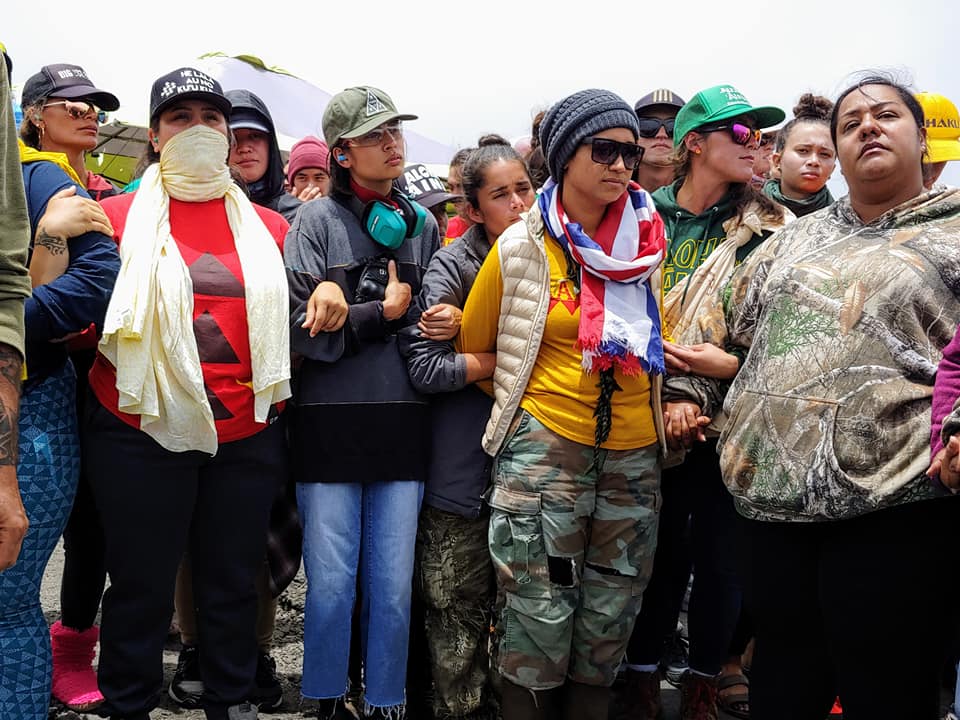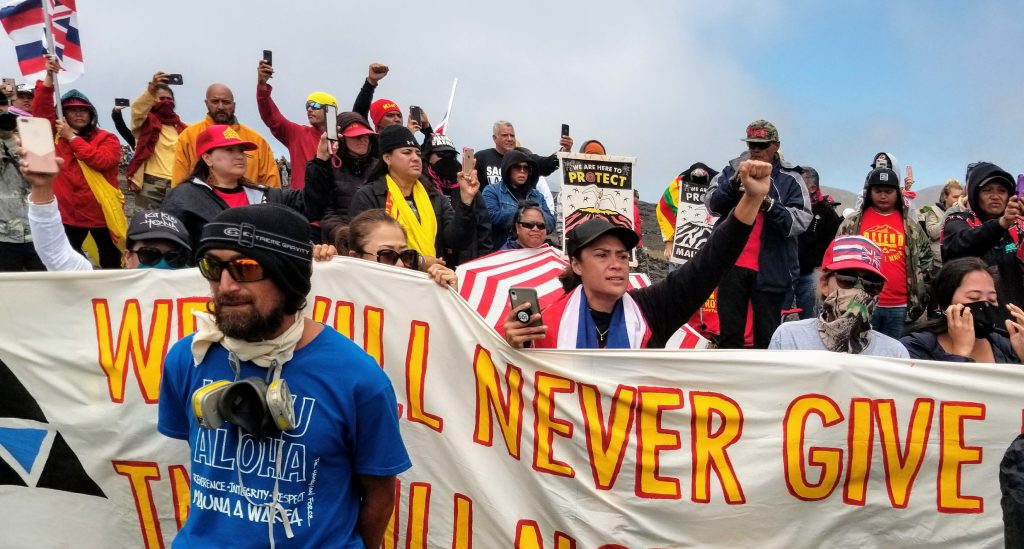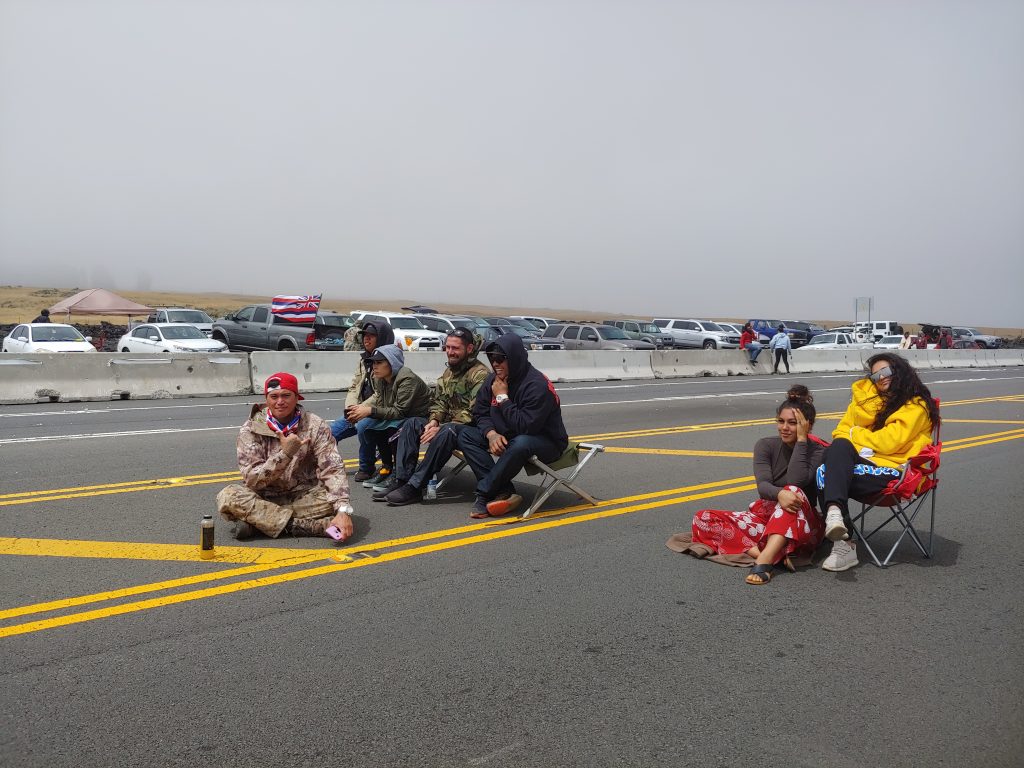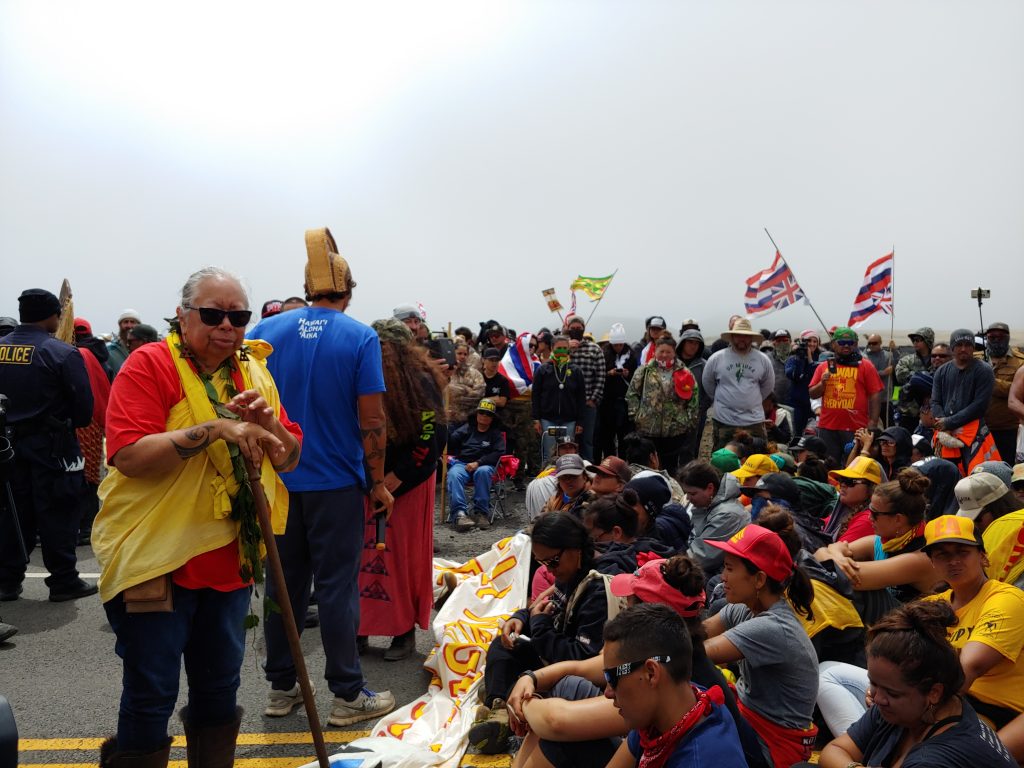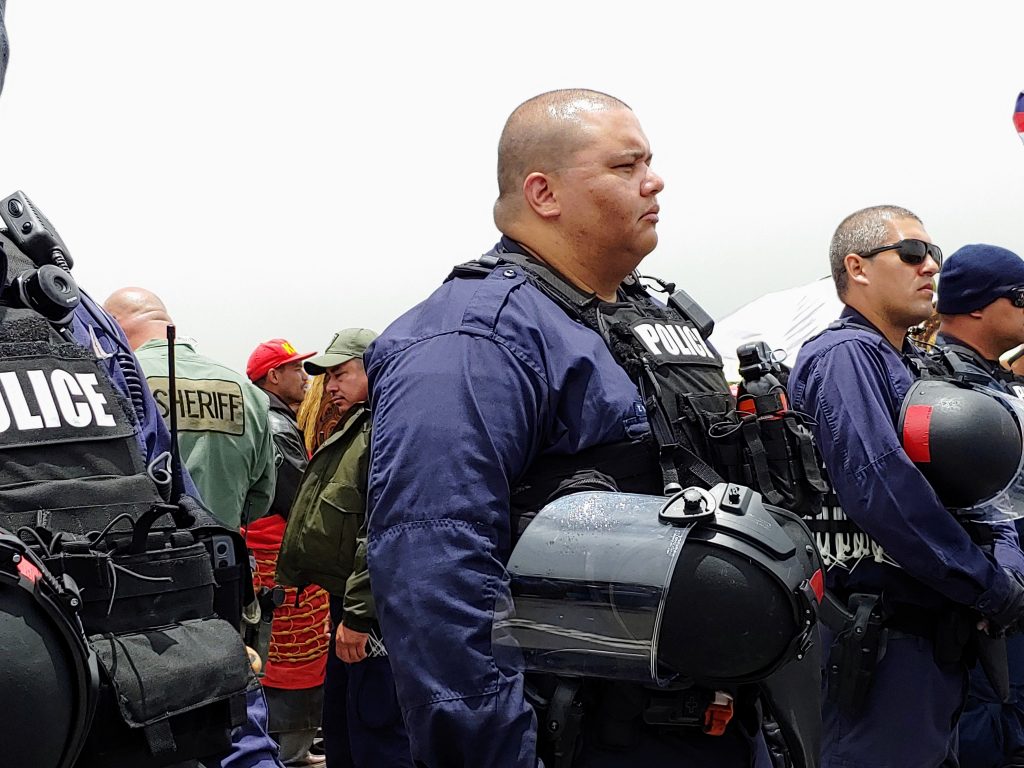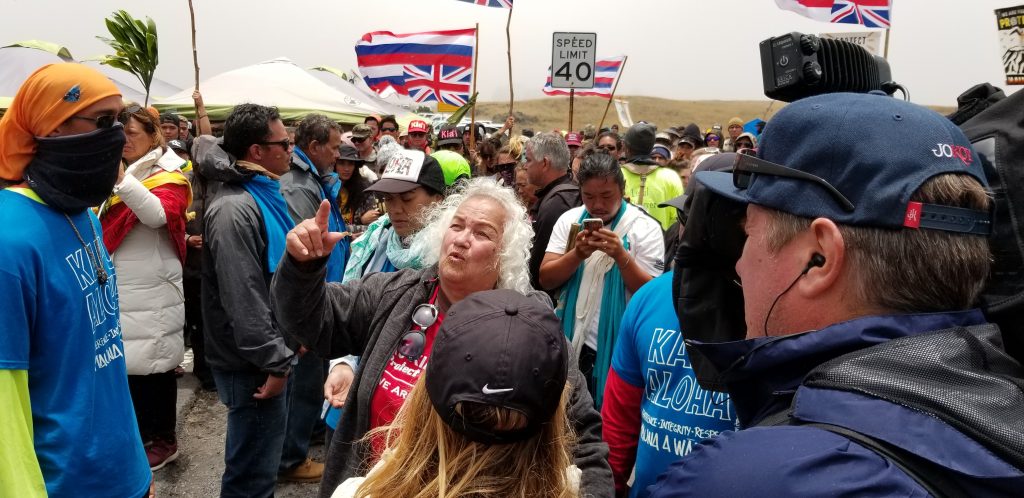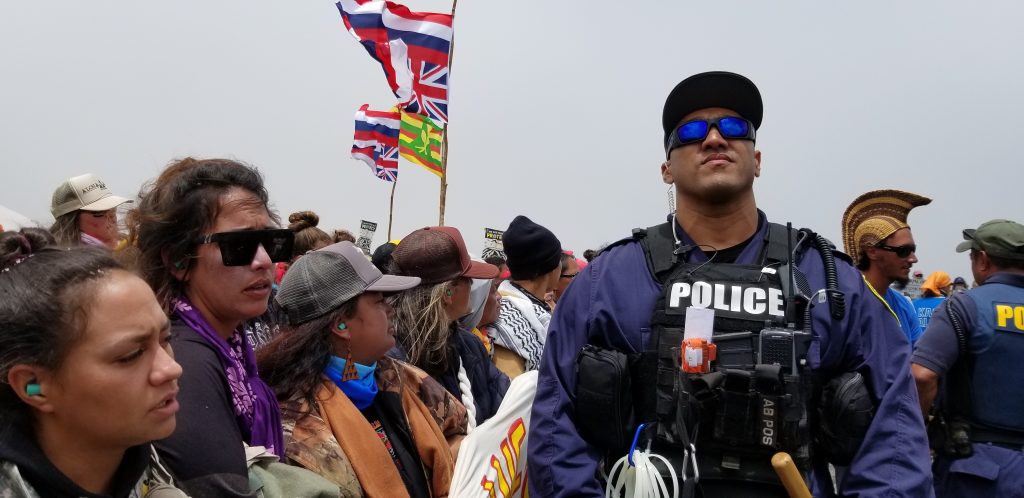UPDATE: TMT Standoff: Emergency Proclamation Issued; Kia‘i Respond
UPDATE: 7:30 PM, July 17, 2019 – Mauna Protectors Respond to Emergency Proclamation
Kaho‘okahi Kanuha and Lanakila Miguel spoke with media about the emergency proclamation issued by Gov. David Ige in response to the Mauna Protectors stand against TMT construction.
“We are hopefully wrapping up the third day of resistance to the desecration of Mauna Kea through the building of the Thirty Meter Telescope,” said Kanuha. “We had another lengthy, but peaceful standoff with law enforcement today.”
He said officers arrived a little before 7 a.m. and began arresting the kūpuna, who had placed themselves on the frontlines.
He said it was a peaceful move on their kūpuna. Kanuha said officers brought in additional reinforcements after the elders were arrested.
“Those officers also conducted themselves in a peaceful manner, however, they did roll in with batons, cans of pepper spray, cans of mace that were clearly visible. The LRAD was out today, they did not use it in a way other than to make announcements,” explained Kanuha. “So, although they did conduct in a peaceful manner, the way we did, we did see all of the police toys that they brought and when they made their way here our people took a stronger stand.”

Women Mauna Protectors block Mauna Kea Access Road on third day of TMT protest, July 17. PC: Crystal Richard
He said there was a line that was about six or seven people deep, which was made up of all women. Behind them were the men and then the kūpuna.
There was a standoff between police and protestors from around 10:30 a.m and 2:30 p.m.
There were no additional arrests made after 10:30 a.m. Kanuha said they were approached about thirty minutes before police retreated and asked to move vehicles that were blocking the highway.
“Asking for certain vehicles that were in the roadway to be removed. It was agreed upon. Once that was agreed upon, we had an agreement that police would retreat,” explained Kanuha. “They did not give us an official timeline on how long, whether it was done for today or they would come back later on today or tomorrow.”
Kanuha then said he wanted to make a point about the vehicles that were in the road.
“The governor held a press conference claiming that the highway was blocked by vehicles of the protectors,” said Kanhua. “Now I ask David Ige, how could a highway that has been blocked on both ends by law enforcement be blocked in the middle? We were not obstructing any traffic because there was no traffic.”
He went on to say people were blocked out from Waiki‘i to down to Kaumana since 6 a.m. this morning. The road actually closed around 11:15 a.m. and reopened as soon as the vehicles were moved around 2:30 p.m.
“So while the governor wants to say the highway was blocked by protectors, I am not exactly sure how you block something that is already blocked. We were stuck inside. Those cars were there, when asked to be moved, they were moved,” explained Kanuha. “We are very concerned about the governor’s irresponsible declaration for an emergency.”
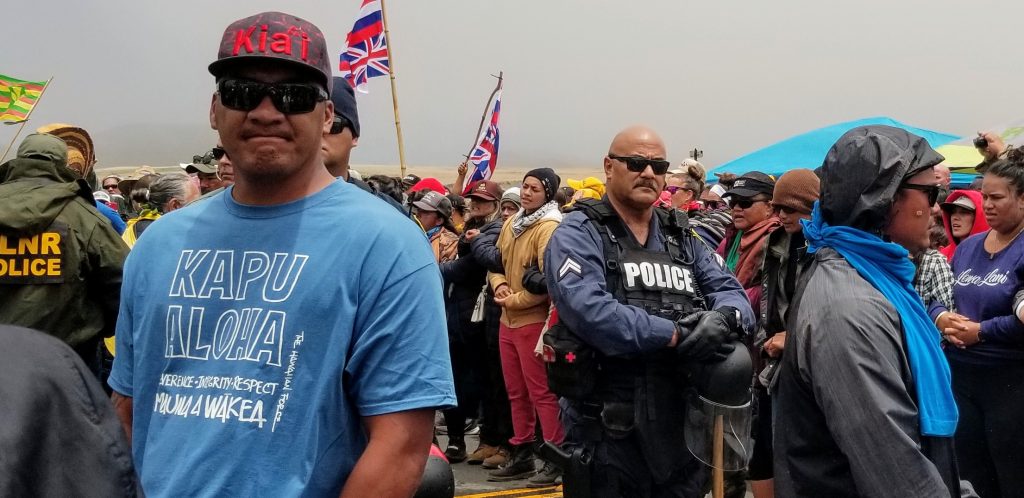
Puna resident Ikaika Marzo stands with Mauna Protectors blocking Mauna Kea Access Road on third day of TMT protest, July 17. PC: Crystal Richard
Kanuha went on to express his concerns over what he said was the state of Hawai‘i’s largest mass law enforcement mobilization.
“They’re utilizing the funds of the people, to protect the rights of foreign investors over the rights of the people of this place,” stated Kanuha. “We all believe it is absolutely irresponsible for the governor to issue this emergency declaration because the people of Hawai‘i, of this place, who are protected by this Constitution and the laws of the State for the benefit of private investors from China, Japan, Canada, India and America. So I ask the governor, how do you justify this type of money, this type of budgeting, this type of mobilization of law enforcement when the people of Hawai‘i have made it extremely clear we are not going to allow the desecration of our mauna anymore.”
Kanuha said that Mayor Harry Kim called him this afternoon. Kanuha reminded everyone of the mayor’s visit to Pu‘u Honua O Huluhulu on Sunday. He said after Sunday’s visit the mayor could tell people were filled with aloha and that they were committed to peace and nonviolence.
“So, today he called me to express his mahalo. He felt that what we did was a beautiful thing,” explained Kanuha. “The way we conducted ourselves was peaceful, it was nonviolent, it was respectful, and we’ve developed a respectful relationship with law enforcement. So, Mayor Kim was absolutely thrilled with how we conducted ourselves, how we communicated with the police officers, how we communicated with our people, and how we conducted ourselves in the face of high use of force. Mahalo Harry Kim for his call.”
He said he looks forward to future talks with Mayor Kim moving forward.

Protectors embrace on Mauna Kea Access Road on the third day of the TMT protest, July 17. PC: Crystal Richard
“Gov. Ige is also basing his proclamation on a matter of safety. We have been completely dedicated to safety here on the mauna. That is also what he expressed, that out of concern for safety for civilians and workers on Hawai‘i Island and their inability to access this highway,” explained Lanakila Mangauil “We want to reiterate, we did not shut down this highway. This highway was shut down by the state. Their actions is what blocked this road and inconvenienced the people of this island in support of international corporations.”
Mangauil said they are dedicated to kapu aloha and maintaining the scared conduct for the safety of all the people involved.
“I echo, we call out to everyone,” he said. “Challenge this proclamation that is being proclaimed on our tax dollars. That is being proclaimed, that is taking vital things away that our communities do need.”
Kanuha said if the governor wants to declare a state of emergency then he does too.
“I want to declare an emergency declaration for the people of Hawai‘i,” said Kanuha. “Our aina is in danger. Our lahui is in danger. The future of our keiki is in danger. Our culture is in danger. So, we are declaring our own emergency. Kanaka of Hawaii, if we want to stop this, if we want to beat this settler state system that is forcing itself upon us, we need to rise up and stand together. Stand together in aloha. If we do not rise up, if we do not take a stand our mountain will be destroyed again, our waters will be gone. The future for our keiki. We are in an emergency state. If we do not react as such, we risk losing it all.”
Kanuha said the time is now to come together.
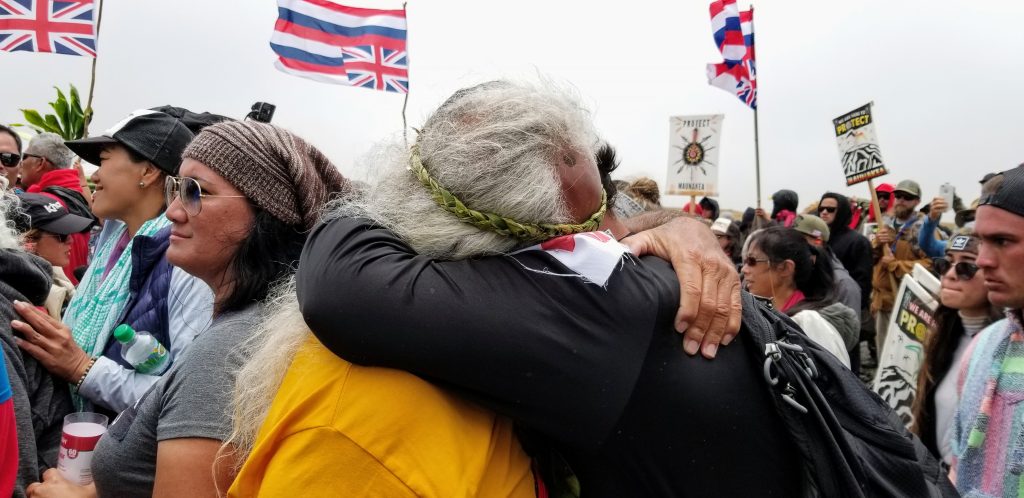
Mauna Protectors Billy Freitas embraces another protector during the third day of the TMT standoff. July 17, 2019. PC: Crystal Richard
ORIGINAL POST
There were an estimated 1,000 people at the intersection of the Daniel K. Inouye Highway (formerly known as Saddle Road) and the Mauna Kea Access Road today, July 17, 2019—day 3 of the Thirty Meter Telescope protest.
Hawai‘i Department of Land and Natural Resources Division of Conservation and Resources Enforcement officers issued citations to 33 individuals. All were almost immediately released.
The citations were issued in accordance with Hawai‘i Revised Statutes for Obstructing Government Operations, a misdemeanor offense. Arraignments at Hilo District Court are scheduled for Sept. 20, 2019, at 8:30 a.m.
Ed Sniffen, Hawai‘i Department of Transportation deputy director, addressed the media earlier today.
“Today, we had a shutdown of Daniel K. Inouye Highway at about 11:15 until about 2:40 today,” Chief Sniffen said. “It was shut down at the intersection of Kaumana Road to the intersection of Waiki‘i Road … about a 30-mile-long section of road.”
Chief Sniffen said the road was closed in those locations so that no one drove all the way up and then had to turn around and go back down.
He said the closure occurred due to cars and people in the highway, not a scheduled or planned closure.
“There were pedestrians that went out into the roadway and cars that blocked the roadway,” said Chief Sniffen. “We wanted to make sure everybody stayed safe, so our highway staff was on hand to ensure that we could shut it down very quickly and efficiently. It was manned with law enforcement to ensure nobody else could pass through.”
The highway is now open due to the movement of those vehicles.
The vehicles blocking the roadway were the negotiating factor in the ending of today’s standoff between state law enforcement and the Mauna Protectors.
The Mauna Protectors were asked to move the vehicles immediately and the officers would stand down.
Once the cars were moved, both the highway reopened and law enforcement retreated.
Chief Sniffen was asked about this agreement.
“I am not sure about that,” said Sniffen. “But during the discussions, we saw many of the protestors head out to the roadway and start moving their vehicles. After that, police left.”
Chief Sniffen was then asked about the heavy equipment seen on Saddle Road a few miles away from the access road. He said the equipment is a combination of TMT’s and the DOT’s.
“We are still doing some work on the barriers to make sure we keep the highways safe,” explained Sinffen. “Some of the [TMT] equipment was moving today. I’m not sure which equipment.”
Chief Sniffen said HDOT was on hand with law enforcement and when they were notified of the situation on the road, they made the decision to shut it down.
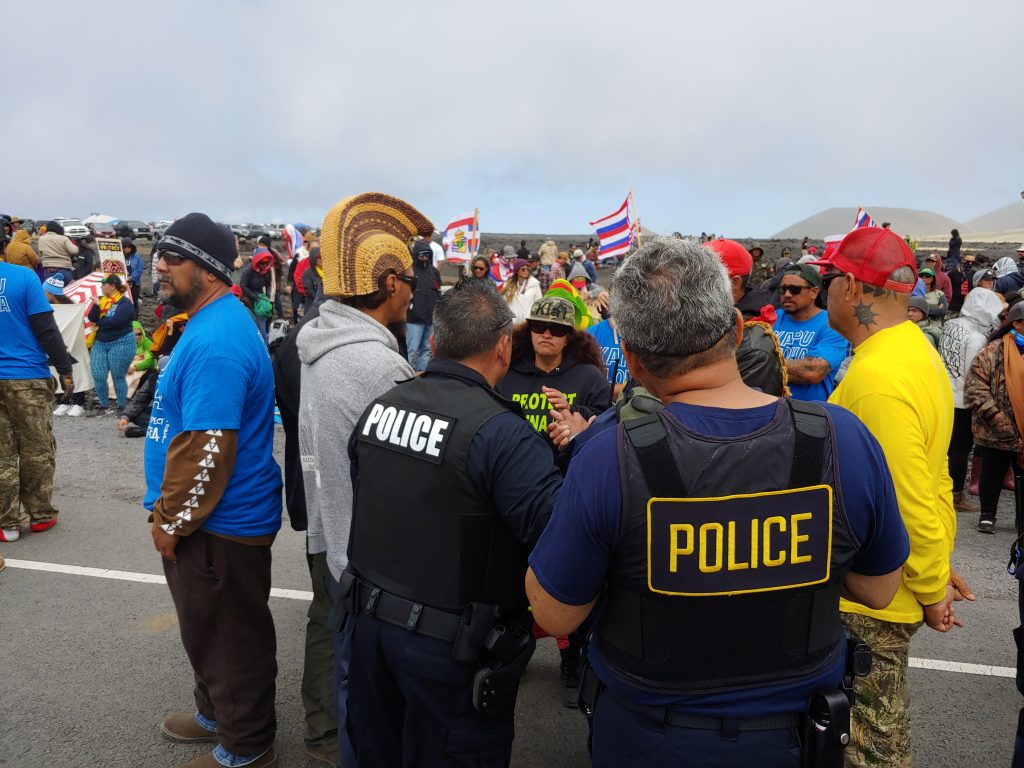
Law enforcement and Mauna Protectors communicate during the third day of protests. July 17, 2019. PC: Crystal Richard
“When law enforcement identifies any situation that is unsafe and lets us know, we shut the roadway down,” he explained.
While some of the vehicles were parked and left unattended in the highway, there was one car with someone locked inside.
When asked why it took so long and why tow trucks weren’t used, Chief Sniffen explained there were two tow trucks on hand but that one vehicle had a person inside.
“It is unsafe to tow a vehicle with a person in it,” explained Chief Sniffen. “So, law enforcement made sure that they wanted to keep everyone safe and worked with that person to make sure that the vehicle was moved.”
She moved the vehicle on her own and the highway was then reopened.
“There was activity in the roadway. When there is activity in the roadway, I don’t want anybody driving quickly in this area,” explained Sniffen.
He was asked what the plan is going forward as the activity in the roadway is likely to continue as the Mauna Protectors continue to protest the construction of this telescope.
“We are hopeful that the protest stays on this side,” explained Sniffen. “We’re hopeful that we won’t impact the whole island and we’re hopeful we don’t have to shut the road down again, but we are going to be prepared to do it to make sure everybody stays safe.”
The state describes this as a very fluid situation.
At 3:30, Gov. David Ige held a press conference announcing he issued an Emergency Proclamation to protect the health, safety and welfare of the people on Hawai‘i Island and across the State of Hawai‘i. The proclamation also aims to ensure the execution of the law and to prevent lawless violence and the obstruction of the execution of the law.
The emergency proclamation gives law enforcement increased flexibility and authority to close more areas and restrict access on Mauna Kea. This will allow law enforcement to improve its management of the site and surrounding areas and ensure public safety.
“Since Monday, protestors have illegally occupied roads and highways,” said Gov. Ige. “We are committed to keep a safe situation. Law enforcement has been extraordinarily patient and respectful towards protestors. However, even though law enforcement has done everything it can to talk and reason with protestors, the protestors continue to break the law.”
The governor said in addition to breaking the law, the protestors continue to place the safety of the public at risk.
“The number of protestors has swelled and their blockage of roads and highways creates a dangerous situation,” stated Gov. Ige. “This affects the ability of first responders to address emergencies and disrupts the publics’ ability to move freely and safely. The protestors’ activities affect our local businesses. Their ability to use Saddle Road and operate.”
He said the conduct of the protestors also diverts law enforcement resources from the protection of the broader community. Gov. Ige also said that the actions of the protestors are endangering their own health, as well as the health of law enforcement, and ultimately, the citizens of Hawai‘i County.
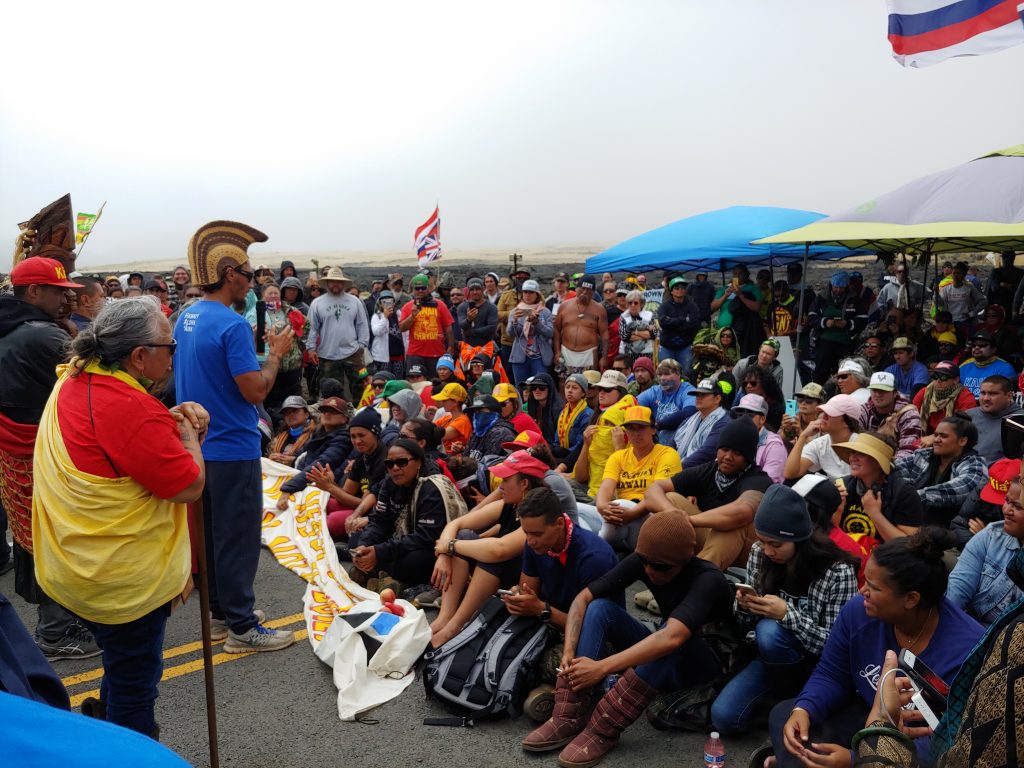
Mauna Protectors discuss negotiation at the end of the third day of protests, July 17, 2019. PC: Crystal Richard
“We are always focused on the safety of our people,” stated Gov. Ige. “We do believe this emergency proclamation gives law enforcement the additional tools that they need to continue to work to keep the people safe.”
The governor was asked, given the hundreds of people protesting not only on Mauna Kea but state-wide, at airports, harbors and freeways, if he felt it was time to “throw in the towel.”
Gov. Ige responded, “We continue to enforce the law and ensure all of those in our community has the opportunity to exercise their legal rights. You know the Thirty Meter Telescope did receive all of the permits it is required to obtain to be constructed and we are certainly committed to ensuring the project has access to the construction site.”
He said they have been patient with protestors expressing their feelings about the project but that they are taking steps to ensure the rights of those involved in the project can get construction underway.
Gov. Ige was then asked why there was such a show of force today and about its significance.
“I don’t think there was anything significant about that other than we had been assessing putting…you know… there were actions that were taken to secure the access road to keep people safe,” stated Gov. Ige.
He said there were a lot of activities that were needed to take place before construction equipment is taken up the mountain to the site.
He was then asked him about the protestors claiming victory three days in a row and if he agreed they had stopped equipment from moving up the mauna.
“I mean, I think we are looking at being able to provide safe access of the equipment to the site and we are committed to do that,” said Gov. Ige. “We did not have an explicit timeline of what that would look like.”
He said the emergency proclamation gives law enforcement the ability to close off more areas of the mountain, restrict access on Mauna Kea, and will give them a way to better provide safe access to the construction site.
“The emergency proclamation does give law enforcement the authority to close more areas of the mountain and the highway to ensure public safety,” explained Ige.
He said it does include most of Mauna Kea.
When asked about what the negotiations made entailed and that activists aren’t going anywhere, he said, “They weren’t really negotiations. It was a lot of conversation and communication about encouraging everybody to be mindful, be safe, and not get out of hand.”
He said it was having a dialogue trying to allow the Mauna Protectors to express themselves. He said Native Hawaiian cultural practices that did not interfere with the moving of the equipment would be allowed but that any effort to block access or illegal acts would not be allowed.
Gov. Ige was then asked about the point of citing the 33 protestors, taking them up the street and releasing them to just return.
“The mechanics of the processing is being handled by law enforcement, Hawai‘i County Police and Hawai‘i County prosecutors, so they have set up what the location would be for each of those activities,” explained Gov. Ige.
One reporter said they have heard frustration from some TMT supporters who say they see law enforcement start to move in and then move out, while the protest movement seems to be building.
“I have wanted to commend law enforcement for all of their actions to this point,” said Gov. Ige. “They have been patient, they have been professional, they have dealt with kūpuna. Be respectful but enforce the law.”
He said the state is accessing with law enforcement to decide what is best moving forward.
Safety remains the state’s number one priority. Fortunately, despite the large crowd on a major highway, there were no injuries reported associated with the protest.
Continue to drive carefully if you are in the area and expect increased traffic and possible delays.



